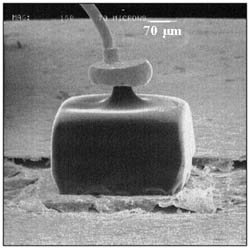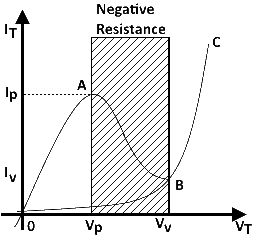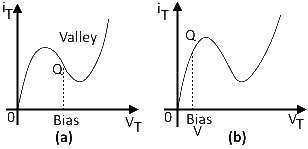Tunnel Diode

This diode was first introduced by Dr. Leo Esaki in 1958. It is called a tunnel diode because due to its extremely thin depletion layer, electrons are able to tunnel through the potential barrier at relatively low forward bias voltage (less than 0.05 V). such diodes are usually fabricated from germanium, gallium-arsenide (GaAs) and gallium antimonide(GaSb).
The commonly used schematic symbols for the diode are shown in Figure. 1. It should be handled with caution because being a low power device, it can be easily damaged by heat and static electricity.
Construction
It is a high conductivity two terminal P-N junction diode having doping density about 1000 times higher as compared t an ordinary junction diode. This heavy doping produces following three unusual effects:
Firstly, it reduces the width of the depletion layer to an extremely small value (about 0.00001 mm).
- Secondly, it reduces the reverse breakdown voltage to a very small value (approaching zero) with the result that the diode appears to be broken down fro any reverse voltage.
- Thirdly, it produces a negative resistance section on the V/I characteristics of the diode.

V/I Characteristic

It is shown in Fig. 2. As seen, forward bias produces immediate conduction i.e. as soon as forward bias is applied, significant current is produced. The current quickly rises to its peak value IP when the applied forward voltage reaches a value VP (point A). When forward voltage is increased further, diode current starts decreasing till it achieves its minimum value called valley current IV corresponding to valley voltage VV (point B). For voltages greater than VV current starts increasing again as in any ordinary junction diode.
As seen from Fig. 2, between the peak Point A and valley point B, current decreases with increase in the applied voltage. In other words, tunnel diode possesses negative resistance (-RN ) in this region. In fact, this constitutes the most useful property of the diode. Instead of absorbing power, a negative resistance produces power. By offering losses in L and C components of a tank circuit, such a negative resistance permits oscillations. Hence, a tunnel diode is used as a very high frequency oscillator.
Another point worth noting is that this resistance increases as we go from Point A to B because as voltage is increased, current keeps decreasing which means that diode negative resistance keeps increasing.
Tunneling Theory
At zero forward bias, the energy levels of conduction electrons in N-region of the junction are slightly out of alignment with the energy levels of holes in the P-region. As the forward voltage is slightly increased, electron levels start getting aligned with the hole levels on the other side of junction thus permitting some electrons to cross over. This kind of junction crossing is called tunneling.
As voltage is increased to peak voltage (VP), all conduction band electrons in the N-region are able to cross over to the valence band in the P-region because the two bands are exactly aligned.
Hence, maximum current (called peak current IP) flows in the circuit
After VP as the applied voltage is increased, current starts decreasing because the two bands start gradually getting out of alignment. It reaches minimum value (called valley current IV) when the two are totally out of alignment at a forward bias of VV (valley voltage).
For voltages greater than VV , current starts increasing again exactly as it does in the case of an ordinary P-N junction diode.
Tunneling is much faster than normal crossing which enables a tunnel diode to switch ON and OFF much faster than an ordinary diode. That is why a tunnel diode is extensively used in special applications requiring very fast switching speeds like high-speed computer memories and high frequency oscillators etc.
Diode Parameters
Negative Resistance (-RN),
It is the resistance offered by the diode within the negative resistance section of its characteristic (shown shaded in Fig. 2. It equals the reciprocal of the slope of the characteristic in this region.
It may also be found from the following relation RN = - dV/dI.
Its value depends on the semiconductor material used (varying from -10 Ohm to – 200 Ohm).
IP/IV Ratio
It is almost as important factor (particularly for computer application) as the negative resistance of the diode.
Silicon diodes have a low IP/IV ratio of 3:1 and their negative resistance can be approximated from RN = - 200/IP. Such diodes are used mainly for switching operating in high ambient temperatures.
Germanium diodes have an IP/IV ratio of 6:1 and their negative resistance formula RN = -120/IP.
GaAs diodes (used exclusively in oscillators) have an IP/IV ratio of about 10:1 and negative resistance nearly equal to that of silicon diodes.
The minimum IP/IV ratio for GaSb diode is about 12:1 and has the lowest resistance of all given by RN = -60/IP. Hence, such diodes have the lowest noise.
Equivalent Circuit
The equivalent circuit of tunnel diode is shown in Fig. 3. The capacitance C is the junction diffusion capacitance (1 to 10 pF) and (-RN) is the negative resistance. The inductor LS is due mainly to the terminal leads (0.1 to 4 nH). The resistance RS is due to the leads, ohmic contact and semiconductor materials (1 – 5 ohm). These factors limit the frequency at which the diode may be used. They are also important in determining the switching speed limit.
Biasing the Diode
The tunnel diode has to be biased from some dc source for fixing its Q-point on its characteristic when used as an amplifier or as an oscillator and modulation.

The diode is usually biased in the negative region (Fig. 3 a). In mixer and relaxation oscillator applications, it is biased in the positive resistance region nearest zero (Fig. 3b).
Applications
Tunnel diode is commonly used for the following purposes:
- As an ultrahigh-speed switch-due to tunneling mechanism which essentially takes place as the speed of light. It has a switching time of the order of nanoseconds or even picoseconds/
- As logic memory storage device – due to triple-valued feature of its curve from current.
- As microwave oscillator at a frequency of about 10 GHz – due to its extremely small capacitance and inductance and negative resistance.
- In relaxation oscillator circuits – due to its negative resistance. In this respect , it is very similar to the unijuction transistor.
Advantages and Disadvantages
- Low noise
- Ease of operation
- High speed
- Low power
- Insensitivity to nuclear radiation
The disadvantages are
- The voltage range over which it can be operated properly is 1 V or less:
- Being a two terminal device, it provides no isolation between the input and output circuits.
